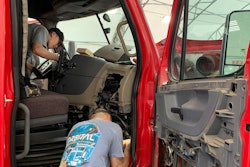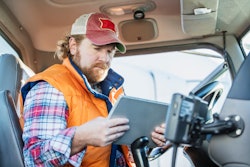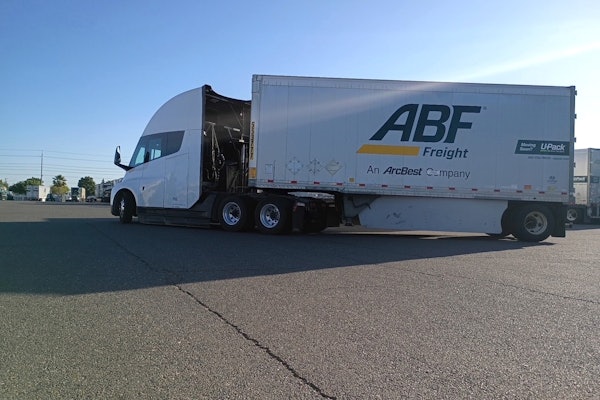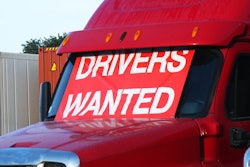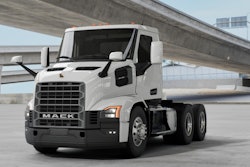To improve the driver experience, many fleets have deployed custom apps that give drivers all the tools they need to complete non-driving tasks – inside and outside the cab – using their personal smartphones.
Many fleets have also deployed the same custom apps on the tablets of ELD systems to give drivers a unified work experience. The real-time communications and structured workflows of the apps remove delays and guesswork, helping drivers meet customer expectations and be more productive and safer.
[Related: Custom driver apps have become must-have tech]
Wal-Mart, for example, released a new driver workflow app last year that it developed internally with a portion of the company’s sizable IT team that consists of more than 250 product managers and 1,200 software engineers worldwide.
The fleet was recognized as a CCJ Innovator for rolling out its new NTransit driver workflow app to more than 13,000 drivers on in-cab tablets also used for its ELD and telematics solution. The company credits the technology for reducing dwell times by 13% and improving communication, on-time deliveries, and driver satisfaction.
Results from Wal-Mart’s driver surveys show a mammoth spike in job satisfaction. Before the new app, the survey’s Net Promoter Score (NPS) was in the teens. The score, on a scale of 100, is in response to the question, “How likely is it that you would recommend this company to a friend or colleague?” The driver NPS jumped to above 90 with the custom app – a clear sign drivers felt listened to and valued.
No fleet operates the same. Each has unique specifications for custom apps that will give their drivers a personalized driving experience. Yet many fleets are stuck, wondering how they can get a custom app that will meet their evolving needs for an affordable price.
The thought of developing a custom driver app can seem like a daunting task. To simplify the process, we have divided the options into four categories:
1) Develop an app with in-house programming resources
2) Use a configurable off-the-shelf app
3) Contract with a third-party app developer
4) Innovate with a custom app platform
The unique needs, budgets, and technical resources of each fleet will impact this decision. Speed of development and total cost of ownership are other important considerations. Let’s evaluate each option based on these factors.
Option 1: Develop an app with in-house programming resources
Like Wal-Mart, some of the nation’s largest fleets develop custom apps with in-house programming resources. If a fleet already has internal developers and analysts, using these resources to create a custom app is not a foregone conclusion. For some, the cost and complexity of building and maintaining their own app will make this option less than ideal.
Many large fleets are choosing to partner with a custom app developer to sidestep the risks of software development. This decision can eliminate many months (or years) of development work and the ongoing expenses associated with maintenance and enhancements. Working with an experienced development partner can also lessen the integration issues you will encounter when pulling data from multiple sources (TMS, ELD, weigh station bypass tools, navigation, etc.) into your new tools.
Option 2: Use a configurable off-the-shelf app
Fleets can address basic needs with off-the-shelf apps. This is typically the cheapest option but with many limitations.
In general, off-the-shelf configurable apps are developed for the masses. As such, they often have necessary features like document capture and dispatch-driver messaging. Some products have configurable settings that allow a fleet to add its logo, and brand colors, and enable or disable certain features and functions.
Yet these products often lack depth and customizability, at the code level, to meet specific workflows required by a fleet. This creates difficulties with adapting apps to meet evolving needs, thus requiring awkward workarounds, and increasing the total cost of ownership and end-user frustration. Drivers may also be required to jump back and forth between multiple apps to find the information they need.
Option 3: Contract with a third-party app developer
Contracting with a software developer to build a custom app has a range of possibilities. Mobile development is difficult overall, but fairly easy to create the first version of a simple app.
Fleets may start with a budget and find a vendor that can develop an app to meet some of their unique requirements. Timelines and costs increase exponentially when more advanced features are added. Fleets often must invest more than what they budgeted to get a production-ready version of their app in the hands of drivers.
In addition, custom app developers who are new to trucking have a steep learning curve. Understanding all the components needed to build a successful app is a difficult task, leading to unnecessary frustration due to dramatic swings in unexpected costs and ever-changing timelines.
Especially problematic is the work required to integrate - and maintain - the various technologies being used by a given fleet. Making the different pieces of an app work seamlessly with ELD telematics, transportation management system (TMS), weigh station bypass, communication tools, training software, and more is a complex and ongoing process.
Option 4: Innovate with a custom app platform
The fourth option allows fleets the flexibility to develop their own custom apps on a SaaS-based platform that includes pre-built transportation components and proven integrations with in-cab technologies. With this option, the platform is continuously updated with new features and capabilities developed in partnership with some of the nation’s most advanced fleets.
The platform approach makes it possible to accelerate deployment, stay on budget, and customize features to meet specific needs like giving drivers access to reliable two-way communications, highly customized workflows, payroll history, truck-safe navigation, safety training content, load permits, and more. You design the system that works best for you, not for the masses.
Like many SaaS-based models, a custom mobile app platform will be billed via a predictable monthly subscription. Understanding your ongoing costs means no surprises, allowing you to budget for your driver app and know you won’t get hit with unexpected expenses.
A flexible SaaS platform makes it easy to add new features to meet evolving company and driver needs, as well as benefit from world-class security and uptime. Since the platform isn’t tied to any specific technology you can change your ELD and TMS systems without disrupting the driver experience. The result, for any size fleet, is a custom app that meets or exceeds their specifications without the expense, time, and frustration of internally developed applications.
In the final analysis, you’ll need to evaluate the pros and cons of each option within the constraints of your IT resources, budgets, and project timelines. Choose wisely and you’ll be able to quickly develop a custom app that keeps your drivers connected, from any location, with all the tools they need to do their jobs as safely and efficiently as possible.
Kevin Survance is chief executive officer of Eleos Technologies in Greenville, S.C. Eleos helps trucking fleets create custom driver apps.




